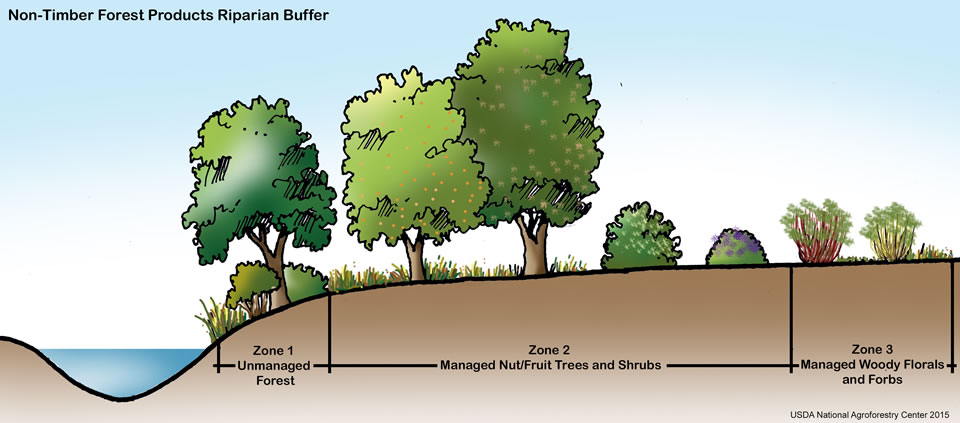1. Design
The design most Riparian Forest Buffers employ is called The Three-zone Concept. The design includes three zones, which are positioned within a certain distance from the water’s edge. Zone 1 is the closest to the water and consists of trees. Zone 2 (middle zone) is usually trees in combination with shrubs and Zone 3 is the furthermost, which borders other land types (such as cropland, pasture or homes/buildings). Zone 3 is usually planted with native grasses and forbs. The combination of fast and slow growing trees, shrubs, grasses and forbs provides a diverse habitat for wildlife and provides protection for the waterways.
Disclaimer: The assortment of riparian zone species varies depending on the landscape type and the location of the intervention. Please check your local forestry/landscape management agency, for more information on local vegetation species.
- For a strategic planning of the correct plant species within the three zones, please click here.
- For an extensive list of riparian vegetation used around the world, please click here.
- For an extensive guide of the holistic design of the riparian buffer and the proper layout of the zones, please click here.

Source
2. Buffer width
The buffer width is the total width of the three zones altogether. There is no generic width that applies to all areas and applications. The considerations that should be taken into account when deciding the width are 1) the function of the buffer zone, 2) slope, 3) soil types, 4)adjacent land uses, 5) floodplain, 6) vegetation type and 7) watershed condition. A leading factor, however, should be the buffer objective/function. The average riparian buffer width is between 10-30 metres.

Riparian buffer width (in feet) for specific objectives (Source)
- For more information on how to decide the specific width for the different zones within the buffer, please click here.
3. Site preparation
The riparian banks are often a mixture of pasture, overgrown fields, branchy poor quality trees along the stream and sometimes a subject to agricultural practices. To prepare the land for planting, a combination of preparation techniques needs to be applied in advance. These can include anything from cleaning/unrooting unwanted species to planting cover crops as preparation for the land. Site preparation should begin in autumn (this may vary for different climatic zones) and it may take up to a year of vegetation control before the process of planting begins.
- For more information on generic preparation techniques, please click here.
4. Plant materials
The techniques, timing and quality of the planting process depends on the type of vegetation and the location of the interventions. Various arrangement strategies exist as well as seasonal planning and local engagement.
- For more information on the planting process, arrangement of the seedlings and timing, please click here.
- For more information on how to strategically arrange the riparian buffer design and the plants that are being used, please click here.
5. Maintenance
The maintenance of the buffer zones includes short term and long term maintenance practices.
- Short-term: The most important short-term maintenance technique is the weed control, which ensures the survival and rapid growth of trees and shrubs in the Buffer in the first years of initiations. For more information on how to convey weeb control, please click here.
- Long term: In the long term, the riparian buffers need to be monitored for their water quality and the benefits provided to the wildlife habitat. Regular inspections need to be conveyed, especially in the case of severe storms in case some repairs need to be made. Furthermore, grasses should be harvested as well as fast growing trees. Finally, it is recommended that no work is being done in the riparian area in the summer season, due to the coinciding mating season for some wildlife Species.
Disclaimer: Riparian systems differ in the different parts of the world, based on different climates, topographies, plant species, etc. Hence, it is crucial to take this implementation guide as a guiding framework and adjust it accordingly to your specific context.
This intervention contributes to:



The overall costs of the riparian buffer zones include the design, permits, planting and maintenance. Depending on the scale and background of those implementing it, some extra costs may be accrued to pay for the workers, technical assistance, field maintenance and construction. The implementation of the buffer zone could be done on a community basis, which could potentially decrease the costs of labour, but it may accrue costs if a training component is needed. Considering all the costs, the creation of riparian buffers has some economic benefits that could offset the costs, including high property values and mitigation of future flood impact costs (NPDES, nd.). The costs listed below do not take into account the prospective benefits accrued as a result of the intervention’s implementation.
Table 1. Costs involved in the preparation, establishment and maintenance of an average riparian buffer zone project (3m buffer strip); All prices are taken in 2024 currency value and the main currency is €; (Source)
| Implementation time |
1 year for the planting (largely dependent on the scale)
5-10 years for maintenance |
| Lifetime |
>25 years |
| Estimated costs |
Planting procedures |
20 €/m |
| Establishment of a 3m buffer strip (including plants) |
400-800 €/ha |
| Maintenance of a 3m buffer strip |
75-150 €/ha |
| Loss of revenue from arable land |
140 €/ha/yr |
A major factor in the implementation and restoration of riparian buffer zones is their scale and often large-scale application. The following case study selection aims to provide a variety of studies, from small-scale interventions to larger, society-based applications.
1. The Stroud Preserve Riparian Reforestation Project, US- Big scale
Description
The Stroud riparian reforestation project took place between 1991-2007, as a demonstration of a 3-zone riparian forest buffer system developed by the U.S. Forest Service. The project included three agricultural watersheds in the Stroud Preserve, which is a highly impacted area from agricultural practices. Before the project’s initiation, the area around the watersheds was primarily devoted to crop production, where water quality is compromised by elevated nutrients and suspended sediments. What the outcome of the project has shown is that the riparian buffer removed on average 27% of nitrate and 52% of sediment that would otherwise reach the stream. Furthermore, erosion levels reached their lowest by the end of the project. Overall, after the finalising of the official project mandate, some maintenance work is still being carried out to protect seedlings from deer damage.
2. Tioga County streamside conservation through riparian buffers, US - Small scale
Description
The Tioga County streamside restoration project is part of the bigger CREP program under US Water Quality Funding. The riparian restoration project included the installation of fences and a watering system for 15 acres of pastures and the planting of 11.3 acres of forested riparian buffer along the stream. A longer-term maintenance is to date being conveyed, to prevent taller vegetation from shading on the smaller samplings. For a video material of the project and some information on the societal relevance, please click here.
3. Family farm riparian buffer restoration in Berryville, Virginia (US)
Description
The family farm of Forrest Pritchard in Berryville, Virginia established their riparian buffer restoration project, raising awareness of the importance of common riparian conservation practices. Some of the observed benefits as a result of the intervention are improved wildlife habitat, reduced soil erosion, improved water quality, increased plant productivity and improved soil health. For more information on the role of riparian buffers in drought control in the area of Berryville, please click here.



